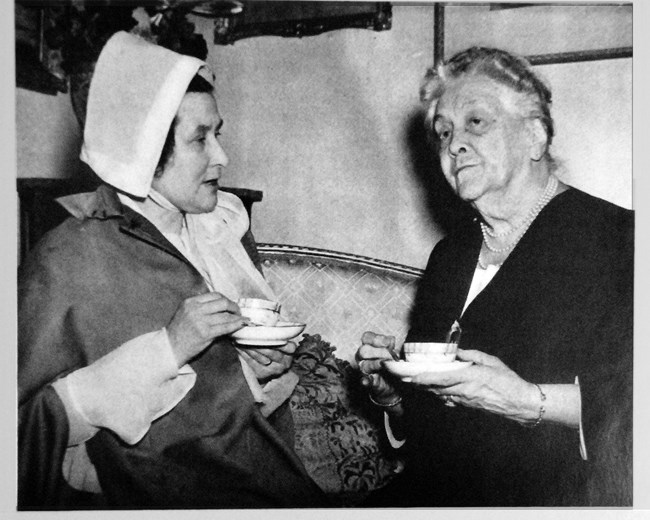Last updated: October 15, 2021
Article
Tablet Recalls Sara D. Roosevelt’s Contribution to the Restoration of St. Paul’s Church

National Park Service
Tablet Recalls Sara D. Roosevelt’s
Contributionto the Restoration of
St. Paul’s Church
A modest granite tablet affixed to a wall in the belfry of St. Paul’s commemorates the contribution of Sara Delano Roosevelt, mother of President Franklin D. Roosevelt, to the 20th century restoration of the interior of the church to its original 18th century appearance.
Mrs. Roosevelt’s involvement in the campaign to restore the sanctuary was facilitated through favorable circumstances. She lived in Hyde Park, New York, which is located only 70 miles north of Mt. Vernon. Founded in the 17th century, St. Paul’s was a venerable, if dwindling, Episcopal parish, the Protestant faith shared by the Roosevelt family.
Of equal importance were the inter-woven themes of family, heritage, preservation and history. The family connection came through both sides. Anne Hutchinson, the bold Puritan religious rebel who lived nearby in the 1640s -- an episode emphasized by the rector William H. Weigle in his accounts of the church’s history -- was a direct ancestor of Sara Roosevelt. Mrs. Hutchinson’s story had particular appeal for Franklin Roosevelt, who spoke with reverence about his enigmatic forebear while visiting St. Paul’s. Additionally, one of the 18th century worshippers, Jacobus Roosevelt, was a distant relative of the Hyde Park family. Although this lineage was of nominal consequence to the Roosevelts, it was magnified by Rev. Weigle, since restoration of the family pew arrangement of 1787 was the cornerstone of his project.
The colonial revival movement, esteeming early American history and the colonial settlers, was a popular cultural development of the day, highlighted by the creation of Colonial Williamsburg in Virginia, which was also designed to maintain the struggling Bruton Episcopal parish. The St. Paul’s undertaking was presented as an extension of that approach to historic preservation, appealing to Mrs. Roosevelt, who was descended from Pilgrim Mayflower passengers. The recognition at the time of St. Paul’s as a shrine to the Bill of Rights, anchored in the Great election of 1733, an early reflection of the significance of freedom of the press and religion, generated interest and support among many people, including the Roosevelts.
Sara was 76 years old in 1931 when Governor Roosevelt’s keynote address at a Descendant’s Day program at St. Paul’s launched the campaign to restore the church and sustain the parish. As an outgrowth of that well attended event, Mrs. Roosevelt accepted an honorary title as Chairman of the Restoration Committee. Over the next ten years her responsibilities for the initiative varied in consistency and application; she would have participated in several other, simultaneous charitable activities. Sara signed letters addressed to potential donors which had been typed by the minister’s wife Anna Weigle, who traveled to Hyde Park with her daughter for afternoon tea. In the final stages of the campaign, months before her death on September 7, 1941 at age 86, the President’s mother hosted a St. Paul’s fund raising tea at her town house on Manhattan’s east side.
But her contribution was ultimately decisive because her name and public identification with the project opened doors to circles of wealthy and influential people, lending the initiative enormous prestige and exposure. Supplementing activities by professional fund raisers, Mrs. Roosevelt was responsible for approximately half of the $40,000 (about $600,000 in today’s money) collected for the project.
The concurrence of her death and the construction phase of the restoration, from early 1941 through the fall of 1942, was the reason behind commemorating her through the granite tablet. Her passing created the framework for the memorial tribute overlapping with the formal re-dedication of the church. Friends of Mrs. Roosevelt, including Father Weigle, designed the unassuming yet elegant tablet.
Dedication of the memorial to the President’s recently deceased mother, coupled with completion of an enterprise that F.D.R. had followed since inception, generated overflow attendance, with national political leaders, as well as live radio coverage and newspaper accounts. It was also December 6, 1942, a year after the attack on Pearl Harbor, and the specter of the world war suffused the afternoon event. Under Secretary of State Sumner Welles, keynote speaker, advanced his call for a post-war United Nations to achieve “the future of a world in which all peoples may be free.” Understandably consumed with critical military and diplomatic obligations, the commander in chief, through a letter read aloud in the restored church, recalled that his mother was “deeply interested in the work carried on through Saint Paul’s and in the preservation of the venerable fabric as a shrine of real historic significance.”
The inscription on the beveled, granite plaque, 34” x 45”, which remains in the original location, illustrates the gratitude extended to the President’s mother for the restoration, labeled a “monument to God,” and a “shrine to the Bill of Rights,” but “accomplished through the untiring efforts of Sara Delano Roosevelt.” Set in a church, under the rector’s influence, the tablet’s concluding line is drawn from the New Testament: “that also which this woman hath done shall be spoken of as a memorial of her”.
